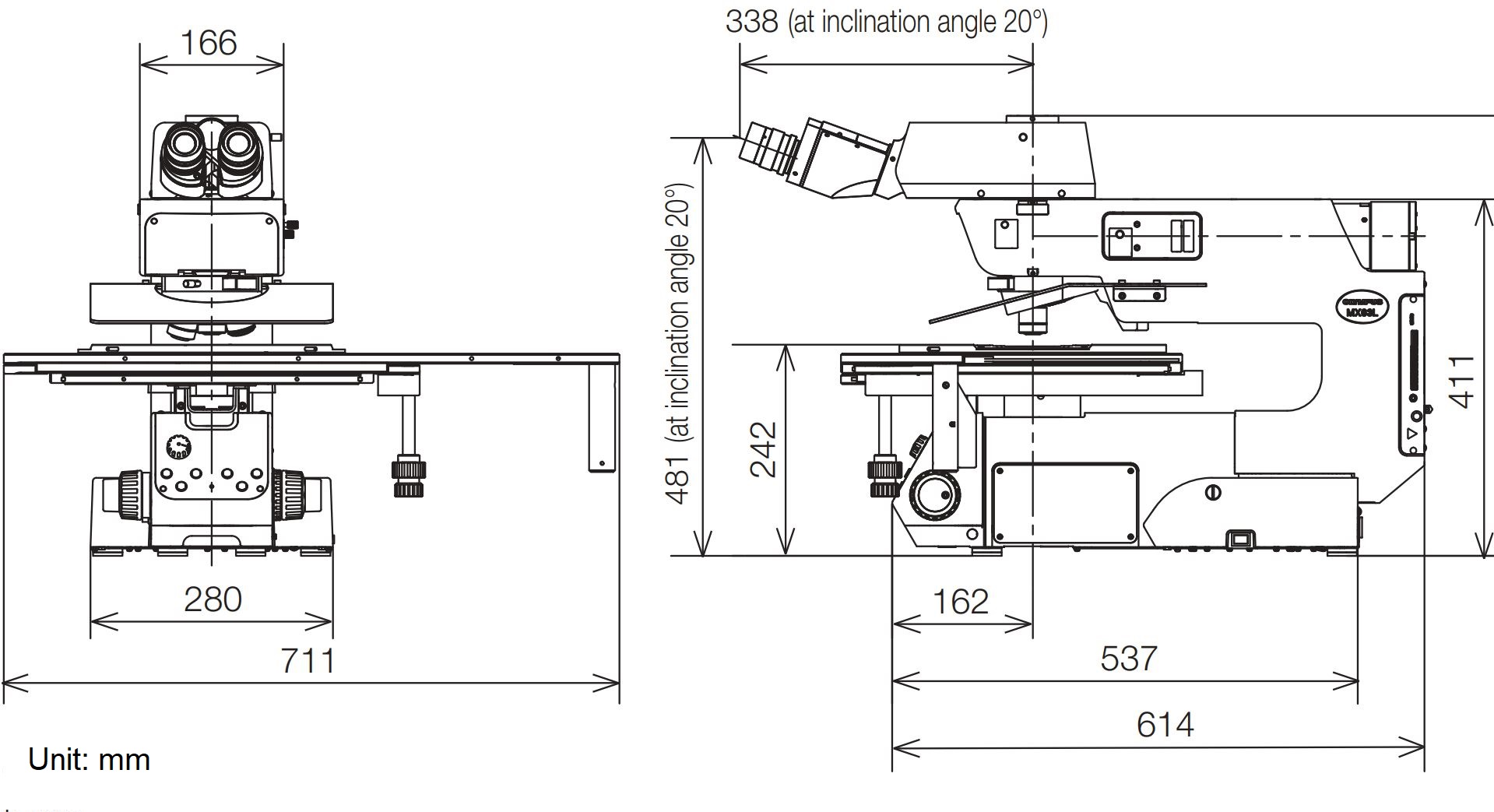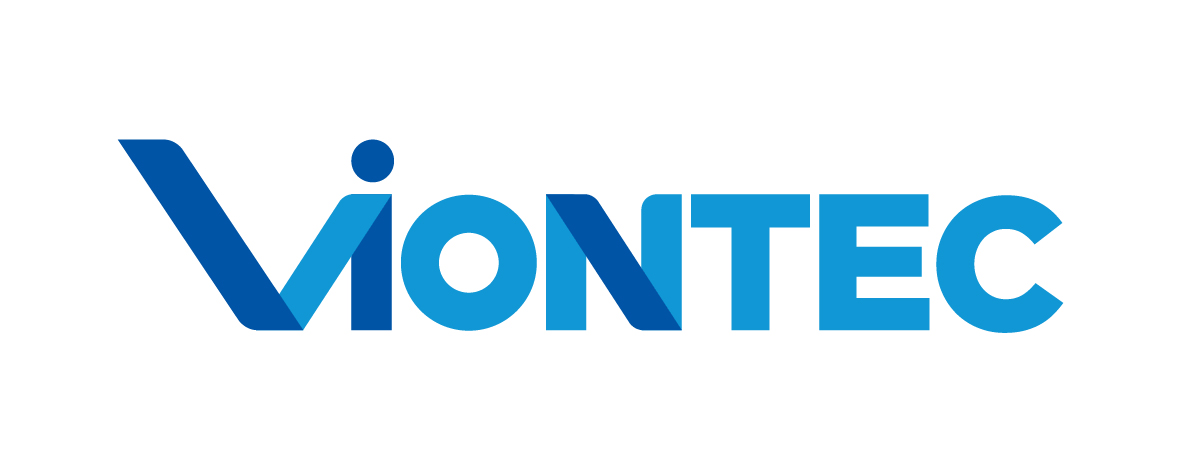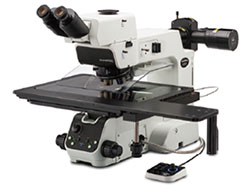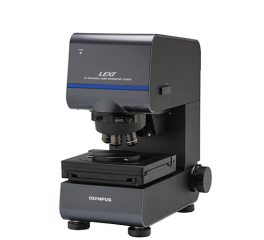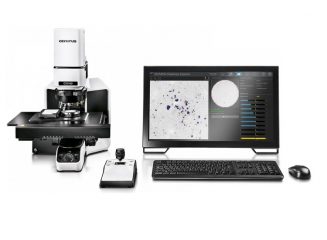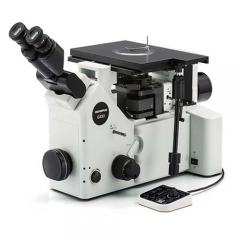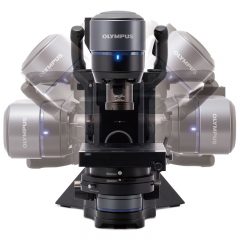
MX63L Advanced Analysis Tools
For more details: MX63L
The MX63 series’ various observation capabilities provide clear, sharp images so users can reliably detect defects in their samples. New illumination techniques and image acquisition options within OLYMPUS Stream image analysis software give users more choices for evaluating their samples and documenting their findings.
The Invisible Becomes Visible: MIX Observation and acquisition
MIX observation technology produces unique observation images by combining darkfield with another observation method, such as brightfield, fluorescence, or polarization. MIX observation enables users to view defects that are difficult to see with conventional microscopes. The circular LED illuminator used for darkfield observation has a directional darkfield function where only one quadrant is illuminated at a given time. This reduces a sample’s halation and is useful for visualizing a sample’s surface texture.



Capture Both Bright and Dark Areas Using HDR
Using advanced image processing, high dynamic range (HDR) adjusts for differences in brightness within an image to reduce glare. HDR improves the visual quality of digital images thereby helping to generate professional-looking reports.

From Basic Measurement to Advanced Analysis
Measurement is essential to quality and process control and inspection. With this in mind, even the entry-level OLYMPUS Stream software package includes a full menu of interactive measurement functions, with all measurement results saved with image files for further documentation. In addition, the OLYMPUS Stream Materials Solution offers an intuitive, workflow-oriented interface for complex image analysis. At the click of a button, image analysis tasks can be executed quickly and precisely. With a considerable reduction in processing time for repeated tasks, operators can concentrate on the inspection at hand.

Applications
Reflected light microscopy spans a range of applications and industries. These are just a selection of examples of what can be achieved using different observation methods.
|
Darkfield / MIX with Brighfield IC pattern on a semiconductor wafer
Darkfield is used to observe scattered or diffracted light from a sample. As only things that are not flat reflect this light, imperfections clearly stand out. Inspectors can identify even minute flaws. Darkfield is ideal for detecting minute scratches or flaws on a sample and examining mirror surface samples, including wafers. |
Fluorescence / MIX with Darkfield Photoresist residue on a semiconductor wafer
This technique is used for samples that fluoresce (emit light of a different wavelength) when illuminated with a specially designed filter cube that can be selected to the specific application. It is suitable for inspection of contamination on semiconductor wafers, photoresist residues, and detection of cracks through the use of fluorescent dye. |
Transmitted Light / MIX with Brightfield LCD color filter
This observation technique is suitable for transparent samples such as LCDs, plastics, and glass materials.
|
|
Differential Interference Contrast Hard disk
Differential interference contrast (DIC) is an observation technique where the height of a sample, normally not detectable in brightfield, is visible as a relief, similar to a 3D image with improved contrast. It is ideal for inspections of samples having very minute height differences such as magnetic heads, hard-disk media, and polished wafers. |
Polarized Light Film
Polarized light observations represent a material’s texture and crystal condition brightly. It is suitable for inspections of wafer and LCD structures.
|
Infrared (IR) Electrode section
IR observation is suitable for nondestructive inspections of defects inside IC chips and other electronic devices constructed with silicon or glass that easily transmit IR wavelengths of light.
|
Specifications
Compare MX63
|
|
MX63L |
|
|
Optical system |
UIS2 optical system (infinity-corrected system) |
|
|
Microscope frame |
Reflected light illumination |
White LED(with Light Intensity Manager) 12 V 100 W halogen lamp, 100W mercury lamp Brightfield/darkfield/mirror cube manual changeover. (Mirror cube is optional.) 3 position coded mirror units changed by manual operation Built-in motorized aperture diaphragm (Pre-setting for each objective, automatically full open for darkfield) Observation mode: brightfield, darkfield, differential interface contrast (DIC)*1, simple polarizing*1, fluorescence*1, infra-red*1 and MIX observation(4 directional darkfield)*2 *1 Optional mirror cube, *2 MIX observation configuration is required |
|
Transmitted light illumination |
Transmitted light illumination unit: MX-TILLA or MX-TILLB is required. – MX-TILLA: a condenser (NA 0.5) and an aperture stop – MX-TILLB: a condenser (NA 0.6), an aperture stop and a field stop Light source: LG-PS2 (12 V,100 W halogen lamp) Light guide: LG-SF Observation mode: brightfield, simple polarizing |
|
|
Focus |
Stroke: 32 mm Fine stroke per rotation: 100 μm Minimum graduation: 1μm Upper limit stopper and torque adjustment for coarse handle |
|
|
Maximum load weight (including stage and holder) |
15 kg |
|
|
Observation tube |
Wide-field (FN 22 mm) |
Erect and trinocular: U-ETR4 Erect, tilting and trinocular: U-TTR-2 Inverted and trinocular: U-SWTR-3 Inverted and binocular: U-BI30-2 Inverted, tilting and binocular: U-TBI30 |
|
Super-wide-field (FN 26.5 mm) |
Erect, tilting and trinocular: MX-SWETTR (optical path switchover 100% (eyepiece) : 0 (camera) or 0 : 100%) Erect, tilting and trinocular: U-SWETTR (optical path switchover 100% (eyepiece) : 0 (camera) or 20% : 80%) Inverted and trinocular: U-SWTR-3 |
|
|
Motorized nosepiece |
Brightfield Motorized sextuple with a slider slot for DIC: U-D6REMC Motorized centerable quintuple with a slider slot for DIC: U-P5REMC Brightfield and darkfield Motorized sextuple with a slider slot for DIC: U-D6BDREMC Motorized quintuple with a slider slot for DIC: U-D5BDREMC Motorized centerable quintuple with a slider slot for DIC: U-P5BDREMC |
|
|
Stage (X × Y) |
Coaxial right handle with built-in clutch drive: MX-SIC1412R2 Stroke: 356 x 305 mm Transmitted light illumination area: 356 x 284 mm
|
|
|
Weight |
Approx. 44kg(Microscope frame 28.5kg)
|
|
Dimensions
